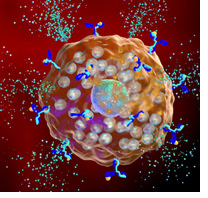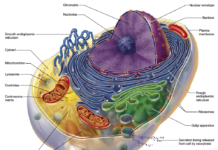 Results from a new national survey demonstrate that elevated allergen levels in the home are associated with asthma symptoms in allergic individuals. The study suggests that asthmatics that have allergies may alleviate symptoms by reducing allergen exposures inside their homes. The work was carried out by researchers at the National Institute of Environmental Health Sciences (NIEHS). The team’s findings may help millions of Americans who suffer from asthma.
Results from a new national survey demonstrate that elevated allergen levels in the home are associated with asthma symptoms in allergic individuals. The study suggests that asthmatics that have allergies may alleviate symptoms by reducing allergen exposures inside their homes. The work was carried out by researchers at the National Institute of Environmental Health Sciences (NIEHS). The team’s findings may help millions of Americans who suffer from asthma.
“Indoor allergen exposures are of great importance in relation to asthma because most people spend a majority of their time indoors, especially at home,” said Darryl Zeldin, MD, a principal investigator in the Laboratory of Respiratory Biology at NIEHS and senior author on the paper.
Asthma is one of the most common chronic ailments in the United States, affecting more than 22 million people. Asthma has been shown to be triggered by a wide range of substances called allergens.
The findings, published online and available in the March issue of the Journal of Allergy & Clinical Immunology, show that exposure to multiple indoor allergens was common in US households with 52 percent having at least six detectable allergens and 46 percent having three or more allergens at increased levels. The indoor allergens studied included those from dog, cat, mouse, cockroach, dust mite, and the fungus alternaria.
The researchers used data from the National Survey of Lead and Allergens in Housing (NSLAH) to examine factors that contribute to high allergen levels in homes and to determine whether elevated household allergen levels were associated with occupants’ asthma status. The NSLAH, which was the first study to characterize how allergen exposures vary in homes at the national level, surveyed the homes of nearly 2,500 individuals in 75 locations throughout the US.
The survey was jointly funded by the NIEHS and the US Department of Housing and Urban Development. Several factors were found to contribute to the increased concentrations of allergens, including race, income, type of home, and sources of allergens, such as presence of pets and pests. The study also showed that homes with children were less likely to have high allergen levels. The authors noted that this finding may not be surprising since homes with children may be cleaned more frequently than homes without children. Regular household cleaning is a simple yet effective regimen that helps to reduce the overall exposure burden.
According to lead researcher Päivi Salo, Ph.D., of NIEHS, the study provides useful information to asthma patients. “Our results highlight the importance of reducing exposure to allergens as a fundamental part of asthma management,” she said. “Although homes cannot be made allergen free, asthmatics that have allergies may need to do a better job in reducing allergen levels in their homes to improve asthma control.”
Allergic Asthma
Allergies occur when the body overreacts to substances that are normally harmless, such as pollen. Some people inherit their allergies, while others become sensitive to specific foods or chemicals following repeated exposure. In either case, once the body has mistakenly identified a substance as foreign, or ‘not self,’ it begins to set the stage for future allergic reactions by producing antibodies against the particular substance.
The next time the specific allergen is detected by an antibody, the immune system goes into high gear, triggering the rapid release of histamine and other inflammatory chemicals from mast cells, a specialized class of immune cells found in connective tissues throughout the body, especially in small blood vessels, skin, and the respiratory tract.
Allergic asthma is characterized by airway obstruction that results in coughing, wheezing (especially on exhalation), shortness of breath and/or rapid breathing that leads to excess mucus, chest tightness, occasional fatigue and slight chest pain.
The best treatment for allergies is to avoid the substances that trigger symptoms in the first. Since this is not always possible, many allergy sufferers turn to prescription and over-the-counter medications for relief. While antihistamines and other drugs may help some patients, they also cause serious problems for others. Typical antihistamines may make even the simplest of tasks, such as driving an automobile or operating heavy machinery, difficult, or even dangerous.
Asthma
Recently a number of clinicians have taken part in evaluting a new, highly effective herbal formula that has been shown to relieve allergic symptoms while gently resolving the underlying imbalances that trigger allergic disorders. The aim of their evaluation program was to determine whether the compound could also aid in assisting those suffering from asthma.
Hyla Cass, MD, one of the country’s foremost authors and speakers on the subject of integrative medicine and one of the first clinicians to evaluate this formula, observed, “I’ve given the formula to numerous patients over the last year. Even in cases where the patient’s allergic symptoms were severe and unresponsive to traditional and alternative therapies, this formula brought about almost immediate and profound relief within 30 to 40 minutes.”
“Additionally, the formula has proved surprisingly effective at relieving asthma symptoms. I was out with a friend one evening who is an asthmatic. Suddenly experiencing an asthma attack, she realized that she had forgotten to bring her inhaler with her. I quickly offered her a few capsules of this Chinese herbal allergy formula and much to our surprise, her asthma attack was completely stopped in its tracks. All of my allergy patients love it, and my professional colleagues are just as impressed as I am by the rapid and safe relief and complete lack of side effects.”
Ward Dean, MD, author of The Neuroendocrine Theory of Aging, and Smart Drugs and Nutrients, I and II, also reported significant success in his evaluation of this formula, writing, “Regarding my experiences with it, the first two patients I tried it on had severe allergies – one with allergic rhinitis, and the other with chronic, low-grade asthma, misdiagnosed by a number of other physicians as “bronchitis” and treated unsuccessfully by a plethora of antibiotics. The girl with allergic rhinitis was blown away by the effectiveness of the formula. She became symptom-free immediately. The patient I diagnosed with asthma also responded rapidly – her chronic, low-grade, unproductive cough ceased immediately.”
In his report Dr. Dean noted that, “Most allergy medications merely relieve symptoms, to a greater or lesser degree, sometimes with other, unwanted side effects. However, with this particular formula, I not only observed rapid relief of symptoms, but long-lasting relief as well. It appeared that something was going on with these patients’ immune systems. I interpreted this to be an immune-normalizing effect.”
Source: NIH/National Institute of Environmental Health Sciences (2008, March 4). Increased Allergen Levels In Homes Linked To Asthma.













